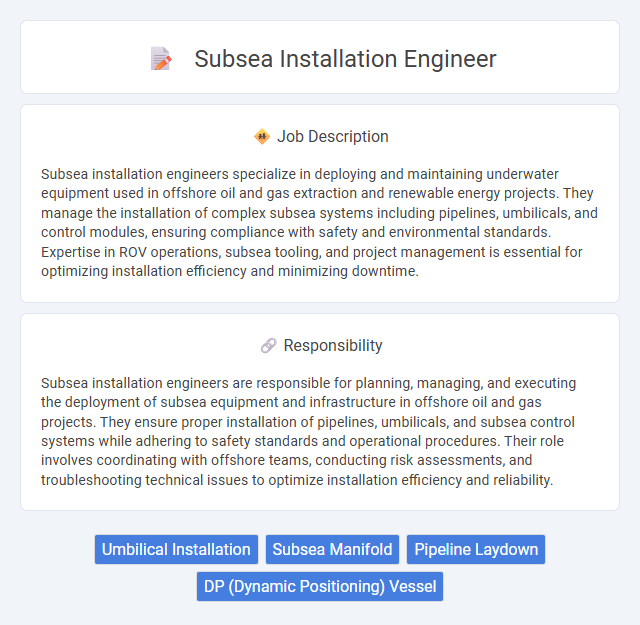
Subsea installation engineers specialize in deploying and maintaining underwater equipment used in offshore oil and gas extraction and renewable energy projects. They manage the installation of complex subsea systems including pipelines, umbilicals, and control modules, ensuring compliance with safety and environmental standards. Expertise in ROV operations, subsea tooling, and project management is essential for optimizing installation efficiency and minimizing downtime.
Individuals with strong problem-solving skills and an ability to work under pressure are likely suitable for a subsea installation engineer role. Those comfortable with physically demanding environments and technical challenges may find this job fitting, while candidates preferring routine or less stressful settings might struggle. Adaptability to offshore conditions and teamwork capabilities probably enhance success in this position.
Qualification
A Subsea installation engineer requires a bachelor's degree in marine engineering, mechanical engineering, or a related field, combined with specialized training in subsea systems and offshore installation techniques. Proficiency in software tools like AutoCAD, PV Elite, and knowledge of subsea equipment standards such as API and ISO is essential. Strong problem-solving skills, offshore safety certifications (e.g., BOSIET), and experience with remotely operated vehicles (ROVs) further enhance job qualification.
Responsibility
Subsea installation engineers are responsible for planning, managing, and executing the deployment of subsea equipment and infrastructure in offshore oil and gas projects. They ensure proper installation of pipelines, umbilicals, and subsea control systems while adhering to safety standards and operational procedures. Their role involves coordinating with offshore teams, conducting risk assessments, and troubleshooting technical issues to optimize installation efficiency and reliability.
Benefit
A subsea installation engineer likely experiences significant career benefits including opportunities for high salary and international work exposure. The role probably offers advancement potential due to the specialized skills required in underwater construction and maintenance. Job stability and industry demand may also be strong given the essential nature of subsea infrastructure in oil and gas exploration.
Challenge
A subsea installation engineer likely faces complex technical challenges related to underwater equipment deployment, requiring precise navigation of harsh marine environments. Managing unexpected conditions such as strong currents or equipment malfunctions may necessitate quick problem-solving and adaptability. The role probably demands continuous learning to stay updated with evolving subsea technologies and safety protocols.
Career Advancement
Subsea installation engineers specialize in deploying underwater equipment and structures critical to offshore oil and gas operations, mastering skills in ROV technology, pipeline installation, and subsea system integration. Career advancement often involves gaining expertise in project management, deepwater technology, and subsea robotics, leading to roles such as senior engineer, project lead, or subsea operations manager. Continuous professional development through certifications and field experience enhances opportunities for leadership positions and involvement in increasingly complex subsea projects.
Key Terms
Umbilical Installation
A Subsea Installation Engineer specializing in Umbilical Installation oversees the planning, coordination, and execution of umbilical cable deployment to ensure efficient power, control, and communication links between subsea equipment and surface facilities. Expertise in handling dynamic positioning vessels, ROV operations, and umbilical management systems is critical to mitigate installation risks in harsh offshore environments. Proficiency in subsea engineering standards, dynamic cable tension monitoring, and real-time installation data analysis optimizes the reliability and integrity of subsea umbilical systems.
Subsea Manifold
Subsea installation engineers specializing in subsea manifold systems are responsible for the design, deployment, and maintenance of critical flow control components in offshore oil and gas fields. Their expertise ensures the reliable installation of manifolds that manage the distribution of hydrocarbons from multiple wells to processing facilities, optimizing production efficiency. Proficiency in subsea construction techniques, ROV operation, and adherence to industry standards like API and ISO certifications is essential for successful project execution.
Pipeline Laydown
Subsea installation engineers specializing in pipeline laydown coordinate the deployment and positioning of subsea pipelines using remotely operated vehicles (ROVs) and specialized lay vessels. They ensure the accurate alignment and stability of pipelines on the seabed, taking into account environmental factors and project specifications to prevent structural damage. Expertise in marine operations, pipeline mechanics, and safety protocols is essential to optimize efficiency and minimize risks during pipeline installation.
DP (Dynamic Positioning) Vessel
Subsea installation engineers specialize in deploying underwater infrastructure using DP (Dynamic Positioning) vessels, which maintain precise positioning without anchors, essential for accurate and safe operations in deepwater environments. Expertise in DP vessel systems, including thruster control and real-time monitoring, enables engineers to coordinate complex tasks such as pipeline laying, riser installation, and subsea equipment placement. Proficiency with DP software and an understanding of environmental factors like currents and seabed topology optimize installation efficiency and minimize operational risks.
 kuljobs.com
kuljobs.com